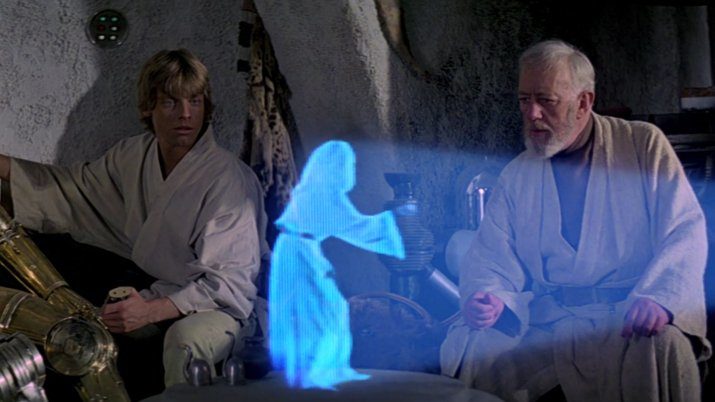
© Lucasfilm
We'd all love for
holograms to be a regular part of daily life. Yes, various attempts have come in the past, but they've all fallen flat, or been forced to carry caveats that make them less interesting.
Finally, though,
scientists at Brigham Young University have managed to achieve the kind of genuine, nigh-tangible
hologram technology that we've all been waiting for.
Through a series of lasers and mirrors, they've found a way to trap a single glowing particle so that it moves constantly along a prescribed path, creating a pattern that forms a visible image that can be seen from any angle, and which genuinely exists in a physical location in three dimensional space.Daniel Smalley, lead author on the
paper in Nature detailing the discovery, describes this as "like a 3D-printed object", but that's only part of the story. In practice, the Optical Trap Display (OTD) is similar to
both 3D printing and modern cinema technology: the particle is told to rapidly move along a set path that traces a shape, but the particle moves so fast that it appears to be a solid object to our slow eyes.
This is apparently hard to see for people and for static cameras, but recording the holograms on film shows how the OTD works, as they video footage shows the 3D images flickering like old tube-based televisions with a low number of frames per second.
The particle is constantly moving, so it appears to be a solid wireframe image, and it's already possible to get the particle to move along impressively complex paths, so that it's possible, for example, to create the BYU logo (you can't blame a bunch of college scientists for wanting to show some home team pride).
Technically this technology doesn't fall under the typical scientific description for "holograms" that are used in modern science, even if it fits the bill a lot better than
most other attempts to recreate the technology that shows up so often in science fiction. Because these particles can create 3D shapes, they're instead given the "Optical Trap Display" label. In practice, though, if this technology takes off, it'll almost certainly become colloquially known as a 3D hologram.
Either that or we'll all start calling them
Iron Man computer displays:
True "hologram" or not, it certainly beats previous attempts.
Nvidia has created "holograms", but they're only visible through the use of augmented reality goggles. Holograms for mice exists, but
they're basically just flashing lights inside a big tube. Even some of the more impressive hologram technology, like the
kind that involves lasers and a thin coating of smoke, is limited in its appeal. Walk too far to the left or the right of the image, and the illusion breaks, shattering all the fun.
There are plenty of uses for this new kind of hologram technology (such as medical training, air traffic control, or just pretending you're in the world of
Tron), although it has to be noted that efforts to develop augmented reality will probably provide an easier solution for many of them. The benefit to OTD holograms is that you don't have to wear glasses in order to see them, which might make them useful for circumstances where lots of people will need to see the display all at the same time.
At present we're still a little ways away from getting this technology to work as we'd all like it to - thus far, scientists have only found a way to manipulate a single particle at a time, where they'll need to be able to move thousands or millions to make a more useful shape out of the technology.
In the meantime, though, it's nice to dream about a future in which the world makes use of
a lot of bright neon holograms at all times - finally, the cyberpunk future that many of us have been dreaming of for decades. Or at least the cool, flashy parts of cyberpunk.
As George Carlin said: "Nobody seems to notice, nobody seems to care".